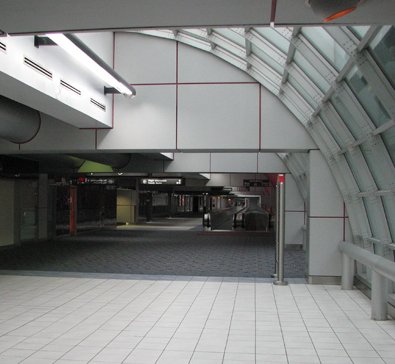 The future of Lambert lies as a regional gateway for flights originating in airports such as Northwest Arkansas, Oklahoma City, Des Moines, Witchita, and Indianapolis. To become an alternate gateway Lambert has to employ design to do a better job capitalizing on its 30+ direct destinations and its manageable size. Removing concourse C provides an opportunity to do just that.
The future of Lambert lies as a regional gateway for flights originating in airports such as Northwest Arkansas, Oklahoma City, Des Moines, Witchita, and Indianapolis. To become an alternate gateway Lambert has to employ design to do a better job capitalizing on its 30+ direct destinations and its manageable size. Removing concourse C provides an opportunity to do just that.
The tornado of April 22, 2011 rendered Lambert’s concourse C inoperable. In the immediate aftermath Lambert was forced to re-open concourse D, the mothballed terminal for TWA and Ozark Airlines. The airport’s current plan is to use potentially $100 million in insurance money to rebuild Concourse C and then deactivate Concourse D., although rumors abound that Concourse C is now structurally unsound and will have to be demolished, current damage assessments have not confirmed this to be true.
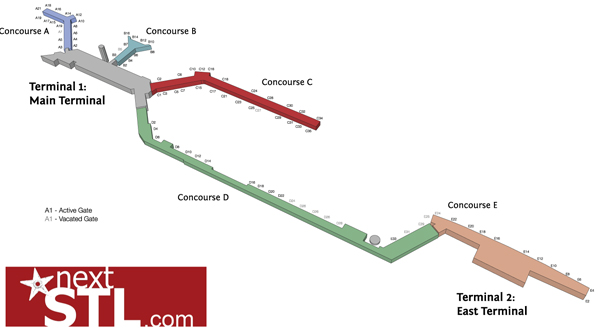
The demolition of 25-gate Concourse C presents the best opportunity for the fututre of Lambert. Removing Concourse C would eliminate the ongoing congestion problem caused when jets on the North side of Concourse C back up and block the taxiway. (P. 91 in the 1998 FAA Record of Decision) In addition, the confined space between terminals C and D would be opened up to allow greater maneuverability and the use of larger aircraft in the D gates. Although Terminal D currently has only 23 gates (including unused Southwest gates E24-E31) the insurance settlement should be combined with the current $125 million renovation to easily add 4-6 additional gates and needed amenities between gates D14 and D16 and the D and E concourses.
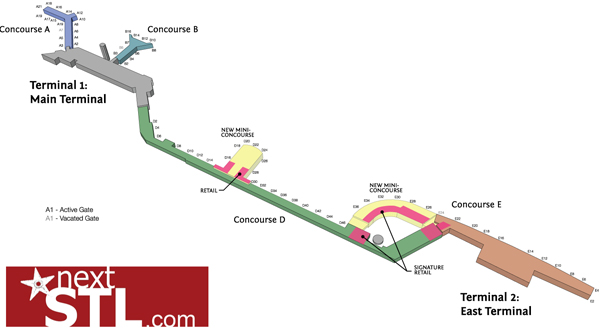
The single greatest reason to reinvest in Concourse D is to reopen the connection between terminals one (west) and two (east). If Lambert is to become a Focus Gateway for the Ozarks and the Great Plains, we have to make interconnection between Southwest and other carriers as seamless as possible.
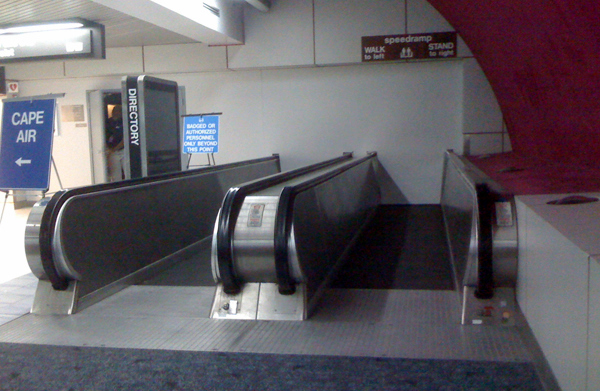 Concourse D is currently cut off from the Southwest gates in Terminal 2. Southwest currently maintains direct flights to Omaha (OMA), Oklahoma City (OKC) and Tulsa (TUL). The majority of the annual traffic in each of these cities connects via American Airlines through Dallas and Chicago. Simply by reconnecting Southwest with American Airlines in Concourse D, Lambert becomes a plausible connection for flyers travelling such routes as Tulsa to Miami (SW/AA) or Omaha to Washington D.C. (SW/AA) If American Eagle were to add a small number of shuttle flights, Lambert could become a connection point for smaller airports such as Northwest Arkansas (XNA), Des Moines (DSM), Wichita (ICT) or Evansville (EVV) due to our good connections through Southwest and American Airlines.
Concourse D is currently cut off from the Southwest gates in Terminal 2. Southwest currently maintains direct flights to Omaha (OMA), Oklahoma City (OKC) and Tulsa (TUL). The majority of the annual traffic in each of these cities connects via American Airlines through Dallas and Chicago. Simply by reconnecting Southwest with American Airlines in Concourse D, Lambert becomes a plausible connection for flyers travelling such routes as Tulsa to Miami (SW/AA) or Omaha to Washington D.C. (SW/AA) If American Eagle were to add a small number of shuttle flights, Lambert could become a connection point for smaller airports such as Northwest Arkansas (XNA), Des Moines (DSM), Wichita (ICT) or Evansville (EVV) due to our good connections through Southwest and American Airlines.
Allocating the Concourse C insurance payout to Concourse D is not enough. In order to attract connecting passengers with convenience, the entire airside of the airport (Concourses A, B, D, E) must be accessible without leaving security. Airports throughout the country, including Nashville, Indianapolis and Rochester are completing renovation and are joining the 22 domestic airports with entirely interconnected terminals. Interconnecting all terminals at Lambert will increase the number of cross-carrier transfers and greatly improve use of the airport as a transfer point and as a gateway from the meta-region to the rest of the country.
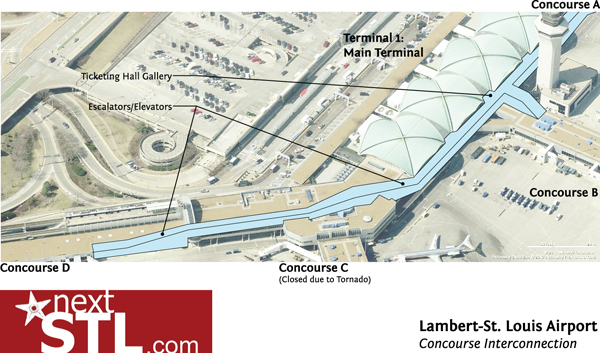
With interconnected terminals St. Louis could become a seamless transfer point for flyers travelling from Omaha to Charlotte (SW/USAir) or Oklahoma City to San Francisco (SW/USAir). With the addition of new shuttle flights the range would increase to include Northwest Arkansas to Salt Lake City (AE/Delta), Wichita to JFK (AE/AA), Evansville to Denver (AE/SW or Frontier), or Indianapolis to LAX (SW/AA).
While not every passenger would choose to fly through St. Louis, Lambert could present a strong alternative to delays and congestion at major hubs. In order to entice more travelers to connect through St. Louis, the appearance and amenities of the terminal will have to be improved. Simply by creating seamless transfers between the four remaining concourses 17 existing restaurants and 15 shops will be accessible to any flyer. Furthermore, the intermingling of passengers from concourse to concourse will form a larger customer base and better support additional retail and food options to the point of legitimating signature retail not currently found in St. Louis.
The emergence of Lambert as a Focus Gateway would stimulate the addition of even more destinations, increase revenue, and have positive effects on the economic climate of the region as a whole. Sadly, Lambert currently appears poised to maintain the status quo at the great expense of reconstructing unneeded space. There is still time to embrace the opportunity presented by the combination of natural disaster and political failure and our region cannot afford to squander this opportunity.
Interested in the future of Lambert International Airport? Join the discussion on the nextSTL Forum.


